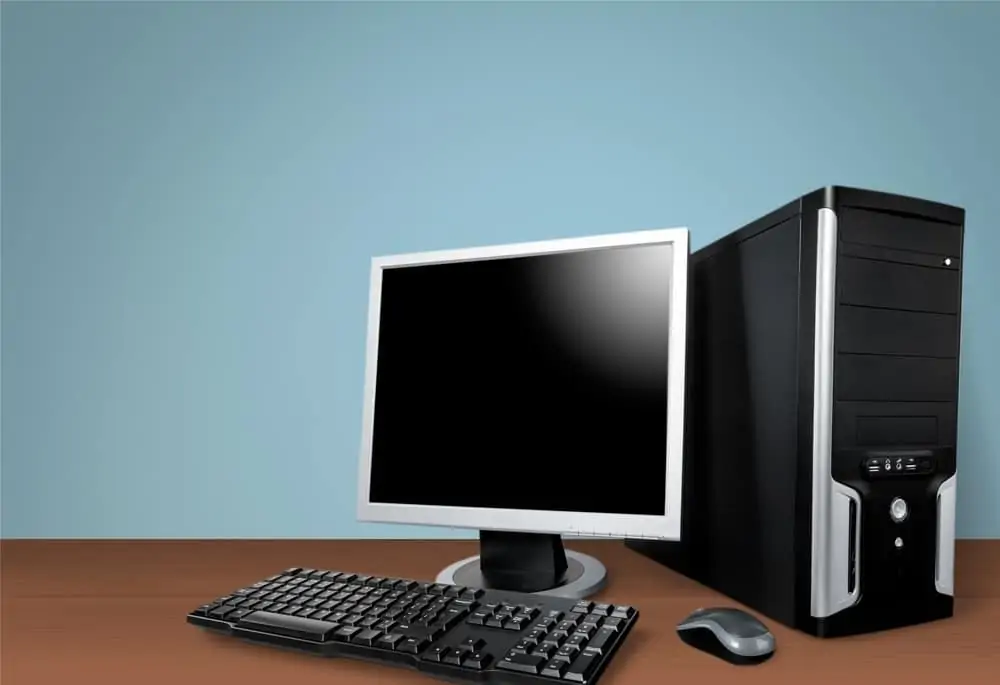Dell XPS 8900 i7: At First Glance
The Dell XPS 8900 is a midrange gaming desktop with a fair mixture of performance and features. At first look, nothing about this desktop or its marketing shouts “gaming”.
It’s sold on the same Dell webpage as any other Dell computer, and the marketing doesn’t really reference gaming. Furthermore, Dell claims that the PC is capable of handling not only recent title games, but also heavy-duty tasks.
Surprisingly, as much as this desktop comes with such power, it is reasonably priced. The Dell XPS 8900 starts at a price of $390.00 when I wrote this review in September 2021.
That seems like a good deal, doesn’t it? However, is it actually a good deal, or is its so-called low price a trap to catch inexperienced gamers?
Read on to find out!
Dell XPS 8900 i7: Design, Dimension & Weight
Except for its Alienware brands, Dell’s XPS 8900 is the company’s most powerful computer. However, you won’t be able to tell by just looking at it.
This is because it features a very simple design. The desktop is rectangular in shape, but the angled front panel curves towards the top, offering a touch of elegance.
Furthermore, the desktop’s front panel is made of glossy black plastic with silver trim. The sides, on the other hand, are made of black aluminum.
The desktop’s top panel and edges are also made of black plastic.
Moreover, there are exhaust vents on the desktop’s sides, as well as on the front panel’s bottom. The only significant element on the front panel is the round white Dell logo, which is located in the middle.
Additionally, there is also an XPS logo on the bottom left of the front panel. In addition to that, there is another XPS logo on the left panel of the desktop.
Moving on, the right panel of the desktop is held in place by a thumbscrew on the back of the desktop.
By removing this thumbscrew, the right panel can be taken off. Therefore, providing access to the inside of the desktop for upgrade or maintenance.
The XPS 8900 comes with loads of ports. Two USB 3.0 ports can be found on the front panel of the desktop, allowing you to easily connect a gamepad.
Moreover, unlike other gaming desktops, this one has four memory card slots on the front panel. The memory card slots are SM/XD, CF/MD, SD/RS/SDXC, and MS/Pro Duo slot.
In addition to the four memory card slots, there is also a DVD-RW drive on the desktop’s front panel.
Furthermore, on the top panel of the desktop, there are two USB 2.0 ports, as well as headphones and mic jacks. These ports are easier to reach if you position the desktop on the floor.
On the rear of the desktop, that is where the majority of the ports are located. These ports include two USB 2.0 ports, four USB 3.0 ports, an Ethernet port, audio lines, three DisplayPorts, and an HDMI port.
With this large amount of ports, I believe every user of the XPS 8900 will be more than satisfied. Moreover, this also means that the XPS 8900 i7 is ideal for productivity, just as it is for playing games.
For wireless connectivity, the XPS 8900 features Bluetooth 4.0, as well as dual-band 802.11ac Wi-Fi on board.
Moving on, Dell sells the XPS 8900 i7 with a USB wired mouse and keyboard. Neither the mouse nor keyboard is anything special.
However, the mouse is much more impressive than the keyboard. The mouse seems well-suited for gaming.
It features thumb buttons on either side, which you can use for extra controls when gaming. Also, at the center of the mouse, there’s a DPI switch that shows the mouse’s sensitivity level through a sequence of LED lights.
The keyboard, on the other hand, features square island keys that are quite stiff, which makes gaming or typing with accuracy difficult. Therefore, you might need to purchase a dedicated gaming keyboard if you plan on playing games seriously.
A minor downside to the XPS 8900 i7 is that Dell sells it with just a one-year warranty. Moreover, the standard warranty period for gaming PCs is around 3-years.
Fortunately, you have the option to upgrade the XPS 8900 i7 warranty period to two, three, or four-year. During the warranty period, you get onsite service and remote diagnosis.
The remote diagnosis allows you to diagnose problems associated with the XPS 8900 using tools from Dell’s website. Additionally, Dell also provides 24/7 customer support via live chat, email, and phone calls.
Moving on to the desktop’s size and weight, it measures 185.3 x 444.2 x 406.8 mm and weighs 13300 g.
The XPS 8900 i7 is quite heavy for its size, but as a desktop, you shouldn’t have to move it about much. Comparatively, the ASUS ROG G20CB is smaller and lighter than the XPS 8900.
Specifically, the ASUS ROG G20CB measures 101.6 x 340 x 355 mm and weighs 10432 g. However, compared to the Alienware Area 51, the XPS 8900 is very small and less heavy.
The Alienware Area 51 measures 271 x 640 x 568 and weighs a mighty 28000 g.
In conclusion, the Dell XPS 8900 is a decently designed machine with lots of ports. Therefore, I will rate the Dell XPS 8900 i7 a nine out of ten in this design review section.
Dell XPS 8900 i7: Processor (CPU) Performance
The Dell XPS 8900 i7 is powered by an Intel Core i7-6700K processor. The Intel Core i7-6700K is a powerful quad-core desktop processor based on Intel’s Skylake architecture.
This processor features an 8 MB cache.
Additionally, this processor has a base frequency of 4.0 GHz and a maximum frequency of 4.20 GHz. With this Core i7 processor, the XPS 8900 can handle demanding tasks like video editing, extreme gaming, and heavy multitasking.
To assess how well the XPS 8900 can perform with its Intel Core i7-6700K processor, I ran a PassMark test. Passmark is an award-winning PC hardware benchmarking tool that lets you examine your computer’s performance.
On this test, the XPS 8900 performs better than all the desktops in its category, scoring a whopping 11000 points. Some of the desktops in its category that scored less are the Origin PC Millennium and Alienware Area 51.
Specifically, the Origin PC Millennium which also uses an Intel Core i7-6700K processor scored 10782 points. The Alienware Area 51, on the other hand, which uses an Intel Core i7-5820K processor scored 10589 points.
The XPS 8900 not only performed brilliantly on the PassMark test, but it also performed well on a Geekbench 3 test. Geekbench 3 features 15 benchmark tests that are aimed to simulate real-world processor-intensive tasks.
Therefore, giving you an insight of what your computer’s processor is capable of doing. Based on the outcome of the Geekbench 3 test, the XPS 8900 scored 20978 points.
This score is slightly higher than the category average of 20847 points. However, the Alienware Area 51 got a slightly higher score, recording 21,060 points on the Geekbench 3 test.
Notwithstanding, the Dell XPS 8900 is still a beast when it comes to processing power. Therefore, in this processor review, it deserves a nine out of ten ratings.
Dell XPS 8900 i7: Memory (RAM) Performance
For memory, the Dell XPS 8900 comes standard with 8 GB 2133 MHz DDR4 RAM in one of four DIMM slots. However, you can upgrade the desktop’s memory to the maximum memory capacity of 64 GB – 16 GB on each slot.
The Dell XPS 8900 I reviewed features 16 GB 2133 MHz DDR4 RAM on one DIMM slot. With 16 GB RAM, the Dell XPS 8900 i7 is an efficient multitasking desktop when you aren’t gaming on it.
The desktop performed flawlessly no matter what I threw at it, even when I was streaming seven videos simultaneously on YouTube. Moreover, I did this while working on MS word and downloading a game on Steam.
I also had about 20 Chrome tabs opened when these tasks were running simultaneously. I carried out a PCMark 8 test on the Dell XPS 8900 to further determine how it can perform with 16 GB RAM.
PCMark 8 benchmark test assesses your computer’s ability to execute common office tasks like web browsing or word processing. On the PCMark 8 test, the Dell XPS 8900 recorded a score of 3,689 points.
This score is almost identical to the Cyberpower Trinity‘s score of 3,693 points. However, the Digital Storm Eclipse was ahead, recording a score of 3,809 points.
In conclusion, the Dell XPS 8900 is an efficient performer when it comes to multitasking. However, it didn’t really live up to the hype on a PCMark 8 test I conducted.
But still, the RAM performance of the Dell XPS 8900 is superb. Hence, I will rate its memory performance an eight out of ten.
Dell XPS 8900 i7: Storage Options & Performance
For storage, the Dell XPS 8900 features an HDD, which supports a max storage size of 2 TB. However, it is a bit disappointing that the desktop does not feature an SSD for faster speed.
Those who prefer storage space to storage speed, on the other hand, will appreciate the HDD storage. The Dell XPS 8900 I reviewed came with 1 TB HDD storage.
1 TB of storage space should be sufficient for most users to save their videos, images, games, and files. However, for those who need more storage space, you could easily upgrade the storage capacity to 2 TB.
Moreover, the Dell XPS 8900 also comes with a one-year free subscribed Dropbox account. Dropbox can be used to back up your important files and share files with others easily.
I conducted two tests to measure the speed of the Dell XPS 8900’s HDD storage. The first test I conducted was a file transfer test.
On the file transfer test, the Dell XPS 8900 duplicated 4.97 GB of files at a rate of 72 MBps. Compared to the MSI Gaming 24GE HDD’s 87 MBps, this transfer rate is quite slow.
Furthermore, the second test I performed was a CrystalDiskMark test. This test measures the read and write speed of an SSD or HDD.
On the CrystalDiskMark test, the Dell XPS 8900 performed less than all the desktops in its category. Specifically, it recorded a sequential read speed of 187 MBps and a sequential write speed of 179 MBps.
Comparatively, the Acer Predator G6 performs better, as expected, recording a sequential read speed of 496 MBps. Also, recording a sequential write speed of 339 MBps.
In conclusion, the Dell XPS 8900 doesn’t feature an SSD, unlike most gaming PCs. Moreover, its HDD storage is quite slow when compared to some of its competitors.
As a result, I will rate the Dell XPS 8900 i7 a seven out of ten in this storage review section.
Dell XPS 8900 i7: Graphics Card Performance
As a gaming PC, the Dell XPS 8900 i7 has three graphics options. The first graphics option is an integrated HD Graphics 530.
The base GPU frequency of this graphics card is 350 MHz. The boost GPU frequency, on the other hand, is 1150 MHz.
As an integrated graphics, the HD Graphics 530 is embedded into the computer’s CPU, and it doesn’t have a dedicated VRAM. As a result, the graphics card shares memory with the CPU, therefore limiting its capabilities and gaming performance.
However, you won’t have to worry about the HD Graphics 530 because the other graphics options are superb. Specifically, the second graphics option is an AMD Radeon R9 370 that features a 2 GB GDDR5 dedicated VRAM.
This graphics card is a discrete graphics card that isn’t embedded into the CPU. That is why it features a 2 GB dedicated VRAM, so it won’t have to share memory with the CPU.
Moreover, the base GPU frequency of the AMD Radeon R9 370 is 925 MHz, while the boost GPU frequency is 975 MHz.
Thanks to its dedicated VRAM and fast clock speed, the AMD Radeon R9 370 is capable of running most games. However, it is not as powerful as the third graphics option which came with my review desktop – NVIDIA GTX 960.
The NVIDIA GTX 960 is also a discrete graphics card that features a dedicated VRAM of 2 GB GDDR5. Moreover, it is better and more powerful than the AMD Radeon R9 370 because it features a faster clock speed.
It is worth noting that clock speed means the base frequency and boost frequency I already specified above.
Specifically, the NVIDIA GTX 960 has a base GPU frequency of 1127 MHz. In addition to its base GPU frequency, it also has a boost GPU frequency of 1178 MHz.
With this NVIDIA GTX 960 graphics card, the Dell XPS 8900 i7 can run most graphics-demanding games even in high graphic setting. For example, while playing GTA V in high graphics setting, the desktop delivered a smooth frame rate of 130 fps.
Impressive right?
Moreover, on the same game, it delivered 146.1 fps in medium graphics setting, and 147.3 fps in low graphics setting. Additionally, I also played Crysis 3, which most gaming PCs and laptops find hard to deliver a smooth frame rate.
However, that wasn’t the case with the Dell XPS 8900 i7 featuring an NVIDIA GTX 960 graphics card. On playing Crysis 3 in high graphics setting, the Dell XPS 8900 i7 delivered an impressive frame rate of 91.7 fps.
Also, while playing the game in a medium graphics setting, it delivered 123.9 fps. Additionally, in a low graphics setting, the Dell XPS 8900 i7 delivered 139.7 fps.
With the NVIDIA GTX 960, the Dell XPS 8900 i7 proves to be one hell of a gaming PC. However, I still conducted a benchmark test to further assess its graphics performance.
Specifically, I carried out a 3DMark Fire Strike graphics benchmark test. On this graphics benchmark test, the Dell XPS 8900 i7 recorded a score of 7916 points.
Comparatively, the Alienware X51 performed less, recording a score of 7298 points. Moreover, the Alienware X51 runs on an NVIDIA GT 545 graphics card.
The only gaming desktop that came close to the Dell XPS 8900 i7 was the Digital Storm Bolt 3. On the 3DMark Fire Strike test, the Digital Storm Bolt 3 that uses an NVIDIA GTX 980 Ti GPU scored 7,727 points.
In conclusion, the Dell XPS 8900 i7 might be a mid-range gaming PC. However, its graphics performance says “high-end gaming PC”.
Therefore, I will rate the Dell XPS 8900 i7 a nine in this graphics review section. This rating is based on the desktop’s performance with the NVIDIA GTX 960 graphics card.
Frequently Asked Questions
Dell released the XPS 8900 in October 2015.
Yes, it is. However, you may find it hard to believe because its design and marketing are unlike other gaming PCs. I can assure you that this desktop is more than capable of running most title high-end games.
Yes, it is. The Dell XPS 8900 comes with 4 DIMM slots which can be used to upgrade the memory to a maximum of 64 GB.
NO! Dell is an American brand.
The Dell XPS 8900 had a starting price of $390 when I published this review in September 2021.
Conclusion
The Dell XPS 8900 i7 is a well-designed gaming desktop that has a speedy performance. This desktop comes packed with lots of powerful hardware, as well as a lot of ports.
However, what is missing is an SSD, which is mostly found on gaming PCs. Instead, the Dell XPS 8900 features an HDD that is comparatively slow when compared to the ones in competing gaming desktops.
Nonetheless, the lack of SSD does not make the Dell XPS 8900 any less of a gaming PC. In fact, it offers multiple graphics card options, and its gaming performance is really outstanding.
I hope you found this Dell XPS 8900 desktop review helpful. If you found the review helpful, kindly click Yes to “Was this page Helpful?” below.
You could also share your thoughts with the “Leave a Comment” form found at the end of this page.
Finally, for more laptop reviews, visit our PC & Mac Reviews page. You may also find our PC & Mac Specs page very helpful.




I bought the XPS 8900 in 2015. I have added a 1tb Samsung SSD along with the 2tb hdd that came with the system, memory is at 64gb, and I installed the Nvidia 3060 12gb video card. It runs Ms flight simulator 2020 flawlessly. It has the I7-6700k. Microsoft says it is not good enough for Windows 11.